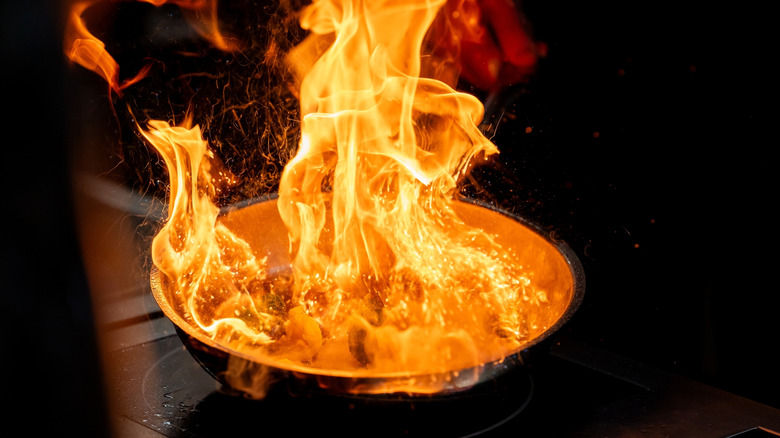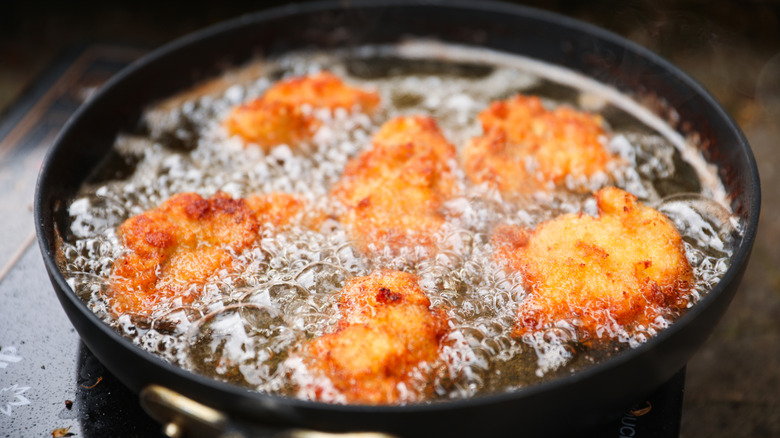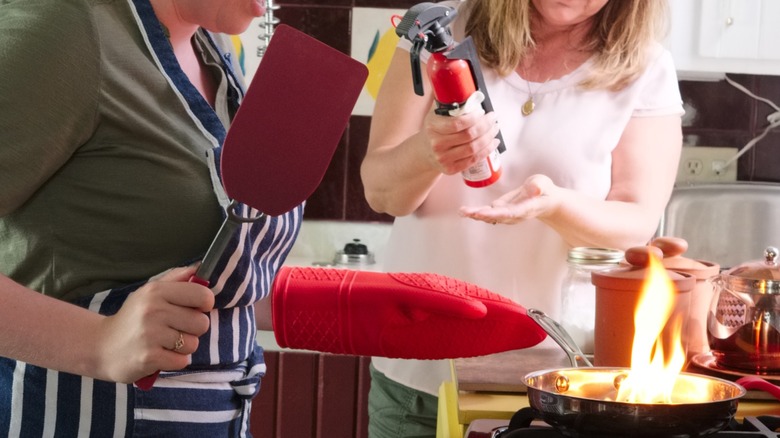The Cooking Mistakes To Avoid Unless You Want To Risk A Grease Fire
We may receive a commission on purchases made from links.
We hate to begin with grim statistics, but some topics are too important to make light of. Between 2017 and 2021, kitchen fires caused 158,400 home fires each year on average along with 4,150 injuries and 470 deaths. Juan Cabrera, executive chef at Yountville, California's The Restaurant at North Block, knows how important it is to take proper kitchen precautions, so he shared some of his top fire prevention tips.
One way to avoid a grease fire is to use oil with a high smoke point. The reason why smoke point matters is simple. "If oil begins to smoke and emit a burning odor or the surface bubbles aggressively and darkens, it signals a potential ignition point," Cabrera told The Takeout. "If oil vaporizes and catches fire, flames can spread rapidly."
As a general rule of thumb, pick an oil with a smoke point at least 50 degrees Fahrenheit higher than the temperature at which you'll be cooking. Cabrera's personal preference is for grapeseed oil, which can be heated as high as 420 degrees. A more budget-friendly option would be soybean oil, which has a smoke point of 450 degrees.
You need to be really careful when cooking with lard, however, since this ingredient is only good up to 370 degrees. Sure, Granny's lard-fried apple pies may be amazing and lard-fried chicken has a flavor that's unbeatable, but if you're using solidified pig fat, you'll need to make sure that cooking temperatures stay below 320 degrees. Deep-frying may well be one of the most dangerous kitchen activities, which is why Cabrera counseled, "Stay away from... any low smoking point oils — safety first."
Other factors that can contribute to a conflagration
Besides using an oil with too low a smoke point, Juan Cabrera warned against making several other cooking mistakes that could potentially lead to a kitchen tragedy. For one thing, don't try to deep-fry too many pieces in the same pan. "Overloading can cause oil to spill over the edges of the stove or other type of cooking equipment, and this can lead to a fire," he said.
He also said you shouldn't immerse cold or wet food in hot oil. "Adding any type of cold food can cause oil temperature to plummet, then rapidly spike, leading to violent bubbling and potential overflow." In the latter, he advised: "Always dry your protein or vegetables. Otherwise, water and hot oil can cause explosive splattering and fire."
It's also important to keep an eye on the oil as you're frying since it doesn't take long to overheat and burst into flames. While you're staring down the pan, though, you could use this time to wipe up the area around it. As Cabrera said, "Accumulated grease on stovetops or ovens can catch fire when exposed to high heat."
How to put out a grease fire
Even when you do take precautions, sometimes accidents happen; that adage about an ounce of prevention being worth a pound of cure doesn't always hold true. Once you see smoke (or worse, flames) shooting from your cooking oil, don't waste time beating yourself up about what you did wrong. Instead, do something to fix the problem.
In order for a fire to keep burning, it needs fuel, heat, and oxygen. Immediately switch off the burner, since this should take care of the first two. Your next step, according to Juan Cabrera: "Use a metal lid or baking sheet to smother flames and cut off oxygen." If the fire is still burning, you can try to smother it with salt or baking soda.
A fire extinguisher rated for kitchen use will also work as will a fire blanket, although the latter will be less likely to contaminate your kitchen with chemicals. In a worst-case scenario, you may need to call 911. The one thing you definitely shouldn't do, however, is pour water on the flames. As Cabrera noted, "This can cause the fire to spread."


